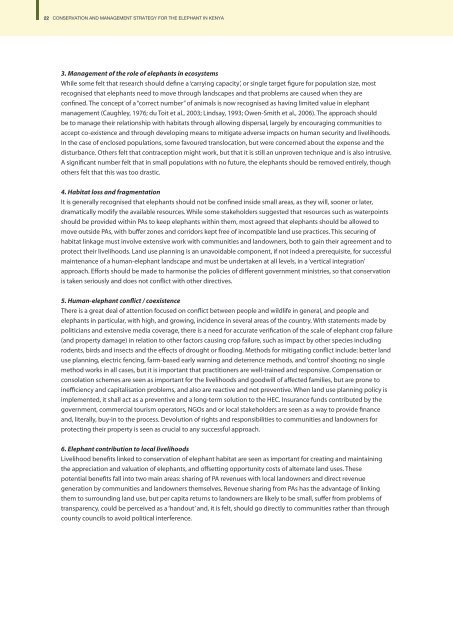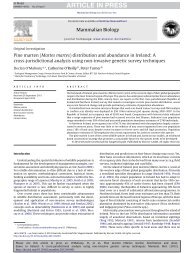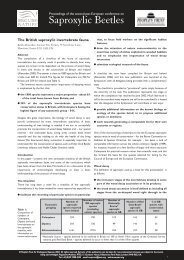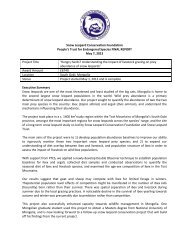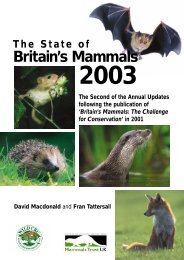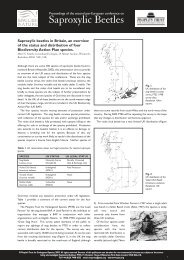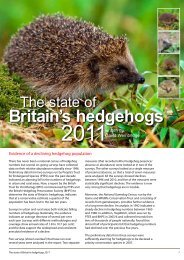National Elephant Strategy - People's Trust for Endangered Species
National Elephant Strategy - People's Trust for Endangered Species
National Elephant Strategy - People's Trust for Endangered Species
You also want an ePaper? Increase the reach of your titles
YUMPU automatically turns print PDFs into web optimized ePapers that Google loves.
22 CONSERVATION AND MANAGEMENT STRATEGY FOR THE ELEPHANT IN KENYACONSERVATION AND MANAGEMENT STRATEGY FOR THE ELEPHANT IN KENYA 233. Management of the role of elephants in ecosystemsWhile some felt that research should define a ‘carrying capacity’, or single target figure <strong>for</strong> population size, mostrecognised that elephants need to move through landscapes and that problems are caused when they areconfined. The concept of a “correct number” of animals is now recognised as having limited value in elephantmanagement (Caughley, 1976; du Toit et al., 2003; Lindsay, 1993; Owen-Smith et al., 2006). The approach shouldbe to manage their relationship with habitats through allowing dispersal, largely by encouraging communities toaccept co-existence and through developing means to mitigate adverse impacts on human security and livelihoods.In the case of enclosed populations, some favoured translocation, but were concerned about the expense and thedisturbance. Others felt that contraception might work, but that it is still an unproven technique and is also intrusive.A significant number felt that in small populations with no future, the elephants should be removed entirely, thoughothers felt that this was too drastic.4. Habitat loss and fragmentationIt is generally recognised that elephants should not be confined inside small areas, as they will, sooner or later,dramatically modify the available resources. While some stakeholders suggested that resources such as waterpointsshould be provided within PAs to keep elephants within them, most agreed that elephants should be allowed tomove outside PAs, with buffer zones and corridors kept free of incompatible land use practices. This securing ofhabitat linkage must involve extensive work with communities and landowners, both to gain their agreement and toprotect their livelihoods. Land use planning is an unavoidable component, if not indeed a prerequisite, <strong>for</strong> successfulmaintenance of a human-elephant landscape and must be undertaken at all levels, in a ‘vertical integration’approach. Ef<strong>for</strong>ts should be made to harmonise the policies of different government ministries, so that conservationis taken seriously and does not conflict with other directives.5. Human-elephant conflict / coexistenceThere is a great deal of attention focused on conflict between people and wildlife in general, and people andelephants in particular, with high, and growing, incidence in several areas of the country. With statements made bypoliticians and extensive media coverage, there is a need <strong>for</strong> accurate verification of the scale of elephant crop failure(and property damage) in relation to other factors causing crop failure, such as impact by other species includingrodents, birds and insects and the effects of drought or flooding. Methods <strong>for</strong> mitigating conflict include: better landuse planning, electric fencing, farm-based early warning and deterrence methods, and ‘control’ shooting; no singlemethod works in all cases, but it is important that practitioners are well-trained and responsive. Compensation orconsolation schemes are seen as important <strong>for</strong> the livelihoods and goodwill of affected families, but are prone toinefficiency and capitalisation problems, and also are reactive and not preventive. When land use planning policy isimplemented, it shall act as a preventive and a long-term solution to the HEC. Insurance funds contributed by thegovernment, commercial tourism operators, NGOs and or local stakeholders are seen as a way to provide financeand, literally, buy-in to the process. Devolution of rights and responsibilities to communities and landowners <strong>for</strong>protecting their property is seen as crucial to any successful approach.6. <strong>Elephant</strong> contribution to local livelihoodsLivelihood benefits linked to conservation of elephant habitat are seen as important <strong>for</strong> creating and maintainingthe appreciation and valuation of elephants, and offsetting opportunity costs of alternate land uses. Thesepotential benefits fall into two main areas: sharing of PA revenues with local landowners and direct revenuegeneration by communities and landowners themselves. Revenue sharing from PAs has the advantage of linkingthem to surrounding land use, but per capita returns to landowners are likely to be small, suffer from problems oftransparency, could be perceived as a ‘handout’ and, it is felt, should go directly to communities rather than throughcounty councils to avoid political interference.Generation of revenue by landowners through community-based natural resource management (CBNRM) andelephant-friendly land use initiatives is seen as more sustainable and directly empowering, allowing individualsand groups to control their level of responsibility, investment and return. Non-consumptive, essentiallyecotourism-related, activities are the only initiatives possible under the current policy. Sources of income couldinclude employment by lodges, partnerships between commercial operators and landowners (leases, employment,joint ventures), community-operated conservancies or camps and cultural tourism. Tourism operations mustcon<strong>for</strong>m to zoning and planning and not damage the resource or relations with local landowners. Other sources ofsupport include NGOs, which offer the possibility of training, employment and the ability to leverage funding andinnovative revenue sources such as trust funds with international and local donors, foundations and Payment <strong>for</strong>Ecosystem Services (PES) schemes. Cross-sector and in-kind benefits in the fields of education (schools, bursaries)and infrastructure (clinics, roads) linked to elephant conservation should also be supported.7. Roles / responsibilities of stakeholdersKWS is recognised as having the mandate <strong>for</strong> elephant management, identifying priorities in consultative processesand having the responsibility to support stakeholders at all levels, empowering landowners and harmonising theactivities of other national and international governmental agencies. People expect KWS to support communityinitiatives, provide security from poachers and HEC and maintain partnerships with CBOs and community wildlifeassociations, NGOs and other government departments. Landowners are seen to play a crucial role in maintainingelephant habitat, and there is strong need <strong>for</strong> their enhanced and well-defined decision-making rights. At the sametime, landowners also have responsibilities <strong>for</strong> conservation of elephant populations and habitats and cooperationwith KWS. Other government departments should harmonise with KWS, recognising conservation as a legitimateland use and ‘mainstream’ conservation in their operations, including conservation education in school curricula.NGOs and private sector should assist with fund-raising, training and the promotion of open, honest dialogue,linking national and international conservation best practice with community development.8. International issuesThere are three key trans-frontier populations along the border with Tanzania, with small populations adjacent toUganda in the west, and Ethiopia and particularly Somalia in the north. There should be regular consultation on theprospects <strong>for</strong> harmonisation of management strategies between Kenya and its neighbours, with the possibility ofan East African regional elephant strategy. Where there is not full agreement on policies and strategies, there shouldbe ‘buffer zones’ in border regions where divergent approaches with potentially adverse cross-boundary effects areavoided. Coordinated approaches should be pursued on, inter alia, protection and law en<strong>for</strong>cement, trade issues,range expansion and maintenance, HEC, CBNRM initiatives, elephant research and monitoring. <strong>National</strong> enactmentof international agreements should be promoted. Inter-governmental organisations should promote moreinter-regional dialogue and collaboration.9. Capacity buildingThere is a perceived need <strong>for</strong> strengthening KWS capacity, particularly in the social development sector (<strong>for</strong>training and communicating with landowners and community organisations on elephant management andmonitoring, CBNRM), Problem Animal Control (PAC) and HEC mitigation, fencing, monitoring and research. Regularre-training of staff at all levels would maintain competence and update skill levels with emerging techniques.Landowners and especially communities need training in small business and conservancy management, fundraising, financial management, project management, monitoring and evaluation, fence management, HECmitigation, anti-poaching and good governance. As noted, KWS could provide a lot of this training, workingparticularly with community game scouts and assisting with equipment. Exchange visits should be arranged <strong>for</strong>community members on learning visits to other areas in Kenya, or in other countries with successful programmes.Other government ministries need to mainstream conservation issues in their programmes.


